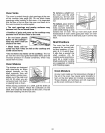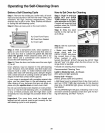
Baking
How to Set Your Range for Baking
1. Position shelf or shelves in oven, tf cooking on two
shelves at the same time, stagger pans for best heat
circulation.
2. Close oven door° Turn OVEN SET knob to BAKE or
TIME BAKE, and turn OVEN TEMP knob to desired
temperature,,
3. Place food in oven on center of shelf, Allow at least
2 inches between edge of cookware and oven walt or
adjacent cookware°
4. Check food for doneness at minimum time on
recipe, Cook longer if necessary. Turn OVEN TEMP
knob to OFF and remove food.
Preheating
Preheating is very important when using temperatures
below 225°R and when baking foods such as biscuits,
cookies, cakes and other pastries. Preheat oven for at
least 10 minutes if preheating is necessary_
Preheating is not necessary when roasting or for long-
time cooking of whole meals
Shelf Positions
Most baking is done on the (B) shelf position,, When
baking three or four items, use two shelves positioned
on the (B & D) supports. Bake angel food cakes on
the (A) shelf position.
Baking Tips
• Follow a tested recipe and measure ingredients careful-
ly, If you are using a package mix, follow label directions.,
• As your oven heats up, the temperature change of
air in the oven may cause water droplets to form on
the door glass. These droplets are harmless and will
evaporate as the oven continues to heat up.
° Do not open oven door during a baking operation--
heat will be lost and baking time might need to be
extended, This could cause poor baking results. If you
must open the door, open it partially--only 3 or 4 inch-
es--and close it as quickly as possible.
• Do not disturb heat circulation in oven with the use of
aluminum foil. If foil is used, place a small sheet of it,
about 10 by 12 inches at most, on a lower shelf sever-
al inches below food. Do not place foil on oven bottom.
Common Baking Problems
and Possible Solutions
PIES
Burning around edges
° Edges of crust too thin_
° Incorrect baking temperature°
Bottom crust soggy and unbaked
° Allow crust and/or filling to cool sufficiently before fill-
ing pie shell.
• Filling may be too thin or juicy.
° Filling allowed to stand in pie shell before baking,
(Fill pie shells and bake immediately.,)
° Ingredients and proper measuring affect the quality of
crust. Use a tested recipe and good technique. Make
sure there are no tiny holes or tears in a bottom crust_
"Patching" a pie crust could cause soaking,
Pie filling runs over
° Top and bottom crust not sealed together wello
= Edges of pie crust not built up high enough.
oToo much filling,,
° Check size of pie plate,,
Pastry is tough; crust not flaky
° Too much handling°
o Fat too soft or cut in too finer Roll dough lightly and
handle as little as possible.
CAKES
Cake rises higher on one side
• Batter spread unevenly in pan_
o Oven shelves not level.
° Warped pans used,
Cakes cracking on top
° Oven temperature too high.,
° Batter too thick, follow recipe or exact package direc-
tions.
° Check for proper shelf position.
o Check pan size called for in recipe.
• Improper mixing of cake.
Cake falls
• Too much shortening, sugar or liquid,,
° Check leavening agent, baking powder or baking
soda to assure freshness,, Make a habit of noting expi-
ration dates of packaged ingredients.
° Cake baked at incorrect temperature or not baked
long enough,,
° If adding oit to a cake mix, make certain the oil is the
type and amount specified.
Crust is hard
° Check temperature.
° Check shelf position,
Cake has soggy layer or streaks at bottom
= Undermixing ingredients.
° Shortening too soft for proper creaming,,
• Too much liquid.
COOKIES & BISCUITS
Doughy center; heavy crust on surface
° Check temperature.
• Check shelf positiOn,r
" Carefully follow baking instructions as given in reli-
able recipe or on convenience food package.,
° Flat cookie sheets will give more even baking
results. Don't overcrowd foods on a baking sheet.,
• Convenience foods used beyond their expiration date,.
Browning more noticeable on one side
° Oven door not closed properly, check gasket seal.
Check shelf position.
22


















